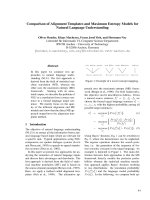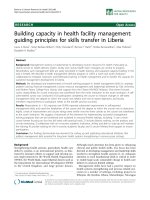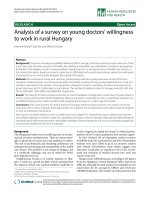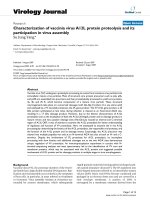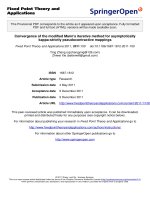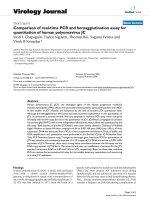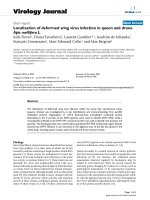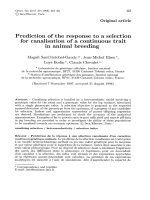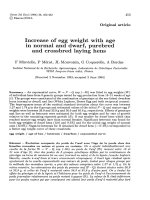Báo cáo sinh học: " Prediction of breeding values with additive animal models for crosses from 2 populations" ppt
Bạn đang xem bản rút gọn của tài liệu. Xem và tải ngay bản đầy đủ của tài liệu tại đây (612.93 KB, 12 trang )
Original
article
Prediction
of
breeding
values
with
additive
animal
models
for
crosses
from
2
populations
RJC
Cantet
RL
Fernando
2
1
Universidad
de
Buenos
Aires,
Departamento
de
Zootecnia,
Facultad
de
Agronomia,
Av
San
Martin,
4453,
(1417)
Buenos
Aires,
Argentina;
2
University
of
Illinois,
Department
of
Animal
Sciences,
1207,
West
Gregory
Drive,
Urbana,
IL
61801,
USA
(Received
5
October
1994;
accepted
24
April
1995)
Summary -
Recent
developments
in
the
theory
of
the
covariance
between
relatives
in
crosses
from
2
populations,
under
additive
inheritance,
are
used
to
predict
breeding
values
(BV)
by
best
linear
unbiased
prediction
(BLUP)
using
animal
models.
The
consequences
of
incorrectly
specifying
the
covariance
matrix
of
BV
is
discussed.
The
theory
of
the
covariance
between
relatives
in
crosses
from
2
populations
is
extended
for
predicting
BV
in
models
with
multiple
traits.
A
numerical
example
illustrates
the
prediction
procedures.
cross
/
heterogeneous
additive
variance
/
segregation
variance
/
genetic
group
/
BLUP-animal
model
Résumé -
Prédiction
des
valeurs
génétiques
avec
des
modèles
individuels
additifs
pour
des
croisements
à
partir
de
2
populations.
De
récentes
avancées
de
la
théorie
de
la
covariance
entre
apparentés
dans
les
croisements
entre
2
populations,
en
hérédité
additive,
sont
utilisées
pour
prédire
les
valeurs
génétiques
(VG)
par
le
BL UP-modèle
animal.
Les
conséquences
résultant
d’une
définition
incorrecte
de
la
matrice
de
covariance
des
VG
sont
discutées.
La
théorie
de
la
covariance
entre
apparentés
en
croisement
à
partir
de
2
populations
est
étendue
à
la
prédiction
de
VG
pour
plusieurs
caractères.
Un
exemple
numérique
illustre
les
procédures
de
prédiction.
croisement
/
BLUP-modèle
animal / variance
génétique
additive
hétérogène
/
variance
de
ségrégation
/
groupe
génétique
INTRODUCTION
A
common
method
used
to
genetically
improve
a
local
population
is
by
planned
migration
of
genes
from
a
superior
one.
For
example,
in
developing
countries,
US
Holstein
sires
are
mated
to
local
cows
in
order
to
genetically
improve
the
local
Holstein
population.
Genetic
evaluation
in
such
populations
must
take
into
consideration
the
genetic
differences
between
the
local
and
the
superior
populations.
Best
linear
unbiased
prediction
(BLUP)
is
widely
used
for
genetic
evaluation
(Henderson,
1984).
BLUP
methodology
requires
modelling
genotypic
means
and
covariances.
Genetic
groups
are
used
to
model
differences
in
genetic
means
between
populations
(Quaas,
1988).
However,
populations
can
also
have
different
genetic
variances.
Under
additive
inheritance,
Elzo
(1990)
provided
a
theory
to
incorporate
heterogeneous
genetic
variances
in
genetic
evaluation
by
BLUP.
His
procedure
is
based
on
computing
the
additive
variance
for
a
crossbred
animal
as
a
weighted
mean
of
the
additive
variances
of
the
parental
populations
plus
one
half
the
covariance
between
parents.
Lo
et
al
(1993)
showed
that
Elzo’s
theory
did
not
account
for
additive
variation
created
by
segregation
of
alleles
between
populations
with
different
gene
frequencies.
For
example,
even
though
the
additive
variance
for
an
F2
individual
should
be
higher
than
for
an
Fl,
due
to
segregation
(Lande,
1981),
Elzo’s
formulation
gives
the
same
variance
for
both.
Lo
et
al
(1993)
provided
a
theory
to
incorporate
segregation
variance
in
computing
covariances
between
crossbred
relatives,
and
to
invert
the
genetic
covariance
matrix
efficiently.
The
objectives
of
this
paper
are:
1)
to
demonstrate
how
the
theory
of
Lo
et
al
(1993)
can
be
used
for
genetic
evaluation,
ie
to
predict
breeding
values
(BV),
by
BLUP;
2)
to
study
the
consequences
of
using
an
incorrect
genetic
covariance
matrix
on
prediction
of
BV;
and
3)
to
extend
the
theory
of
Lo
et
al
(1993)
to
accommodate
multiple
traits.
A
numerical
example
is
used
to
illustrate
the
principles
introduced
here.
MODEL
Even
though
the
theory
presented
by
Lo
et
al
(1993)
allowed
for
several
breeds
or
strains
within
a
breed,
we
focus
on
the
case
of
2.
A
typical
situation
in
beef
or
dairy
cattle
is
when
a
’local’
(L)
strain
or
breed
is
crossed
with
an
’imported’
(I)
one.
Usually
the
program
starts
by
mating
genetically
superior
L
females
with
I
males
to
produce
Fl
progeny.
Then
superior
Fl
females
are
mated
to
I
sires
to
produce
backcross
progeny.
The
program
is
continued
by
repeatedly
mating
superior
backcross
females
to
I
sires.
It
should
be
noted
that
L,
Fl
and
backcross
sires
are
also
used
to
produce
progeny.
Thus,
the
crosses
generated
by
such
a
program
may
includeFl=IxL,F2=FlxFI,BI=IxFI,BL=FlxL,BII=BIxF
l,
5/81
=
BI
x
Fl,
3/81
=
BI
x
L,
etc.
It
is
shown
below
how
genetic
evaluations
for
such
a
mixture
of
crossbred
animals
can
be
obtained
by
BLUP
using
Henderson’s
(1984)
mixed-model
equations
(MME).
Genetic
evaluations
are
based
on
a
vector
of
phenotypic
records
(y),
which
can
be
modelled
as:
where (3
is
a
vector
of
non-genetic
fixed
effects,
a
is
a
vector
of
additive
genetic
values
or
BV
and
e
is
a
vector
of
random
residuals,
independent
of
a,
with
null
mean
and
covariance
matrix
R.
Although
R
can
be
any
general
symmetric
matrix,
in
general
it
is
taken
to
be
diagonal,
and
this
simplifies
computing
solutions
of
(3
and
predictions
of
a.
The
incidence
matrices
X
and
Z
relate
(3
and
a,
respectively,
to
y.
The
mean
and
the
covariance
matrix
of
the
vector
of
BV
(a)
for
crossbred
individuals
are
modelled
as:
and
, ,
L
where
g
is
a
vector
of
genetic
group
effects
for
individuals
in
the
I
and
L
populations,
Q
is
a
matrix
relating
a
with
the
genetic
groups.
If
there
is
only
1
group
on
each
breed,
Q
specifies
the
breed
composition
for
each
individual.
The
matrix
G
contains
the
variances
and
covariance
among
BV
as
defined
by
Lo
et
al
(1993).
In
modelling
the
mean
of
a,
genetic
groups
are
only
assigned
to
’phantom’
parents
of
known
animals
following
the
method
proposed
by
Westell
et
al
(1988).
Quaas
(1988)
showed
that
Q
can
be
expressed
as:
where
P
relates
progeny
to
parents,
P6
progeny
to
phantom
parents,
and
Qb
is
an
incidence
matrix
that
relates
phantom
parents
to
genetic
groups.
Elements
in
each
row
of
[P
b
:P]
are
all
zero,
except
for
two
1/2’s
in
the
columns
pertaining
to
the
parents
of
the
animals
in
a.
It
should
be
stressed
that
the
above
model
for
a
assumes
additive
inheritance
(Thompson,
1979;
Quaas,
1988;
Lo
et
al,
1993).
In
the
genetic
grouping
theory
of
Quaas
(1988),
all
the
groups
are
assumed
to
have
the
same
additive
variance.
In
this
model,
however,
we
allow
the
I
and
L
populations
to
have
different
additive
variances,
and
the
variances
and
covariances
of
crossbred
animals
are
computed
following
the
theory
of
Lo
et
al
(1993).
They
showed
that
the
covariance
between
crossbred
relatives
can
be
computed
using
the
tabular
method
for
purebreds
(Emik
and
Terril,
1949;
Henderson,
1976),
provided
that
the
variance
of
a
crossbred
individual
i
is
computed
as:
where j
and
k
are
the
parents
of i,
and
f
jl
,
for
example,
is
the
breed
I
composition
of
dam
j,
QAL
is
the
additive
variance
of
population
L,
U2
is
the
additive
variance
for
population
I,
and
QALI
is
the
segregation
variance,
which
results
from
differences
in
gene
frequencies
between
the
L
and
I
populations.
The
term
segregation
variance
was
used
by Wright
(1968)
and
Lande
(1981)
to
refer
to
the
additional
genetic
variance
due
to
segregation
in
the
F2
generation
over
that
in
the
Fl.
Following
Quaas
(1988),
Lo
et
al
(1993)
further
showed
that
the
inverse
of
the
genetic
covariance
matrix
(G),
required
to
setup
Henderson’s
MME,
can
be
constructed
as:
where
G,
is
a
diagonal
matrix
with
the
ith
diagonal
element
defined
as:
Note
that
these
elements
are
linear
functions
of
a 2
2
and
!ALI!
PREDICTION
OF
BREEDING
VALUES
Following
Quaas
(1988),
MME
for
a
model
with
genetic
groups
can
be
written
as:
where
and
The
matrix
H
can
be
constructed
efficiently
using
algorithms
already
available
(eg,
Groeneveld
and
Kovac,
1990).
Quaas
(1988)
gave
rules
to
construct
E
effi-
ciently
for
a
model
with
homogeneous
additive
variances
across
genetic
groups.
To
construct
E
efficiently
for
a
model
with
heterogeneous
additive
variances,
replace
x(=
4/[number
of
unknown
parents
+
2!)
in
the
rules
of
Quaas
(1988)
with
1/Gg
i.
CONSEQUENCES
OF
USING
AN
INCORRECT
G
Henderson
(1975a)
showed
that
using
an
incorrect
G
leads
to
predictions
that
are
unbiased
but
do
not
have
minimum
variance.
His
results
are
employed
here
to
examine
the
consequences
of
using
the
same
additive
variance
(
QA
*
)
for
L,
I
and
crossbred
animals.
Let
Caa
be
the
submatrix
of
a
g-inverse
of
the
right-hand-side
of
the
MME
corresponding
to
a,
but
calculated
with
G*
=
Aa2 A
Then,
as
in
Henderson
(1975a)
and
Van
Vleck
(1993),
the
prediction
error
variance
(PEV)
of
a
is
not
equal
to
C
aa
,
but
is:
where
G
is
the
correct
covariance
matrix
of
a.
Now,
let
D
be
a
diagonal
matrix
with
the
ith
diagonal
element
being
equal
to
0.5[1 -
0.5(Fs
i
+
FDi)!,
if
the
father
(Si)
and
the
mother
(Di)
of
i
are
known,
and
F
si
is
the
inbreeding
coefficient
of
Si.
Also,
D
ii
=
0.25(3 -
Fs
i
),
if
only
the
sire
of
i is
known,
and
D
ii
=
0.25(3 —
F
Di
)
if
only
the
dam
of
i is
known.
Finally,
if
both
parents
of
i
are
unknown
D
ii
=
1.
With
this
definition
of
D
and
after
some
algebra,
[11]
becomes
equal
to:
Therefore,
PEV
of
a
obtained
from
Caa
will
be
incorrectly
estimated
by
the
second
term
on
the
right
of
[11]
or
[12].
As
this
term
depends
on
the
structure
of
G,
and
D,
no
general
result
can
be
given.
However,
if
caa(I-p’)D-1(Go -D)D-1(I-p)caa
is
positive
definite,
it
adds
up
to
C&dquo;
and
true
PEV
is
underestimated.
This
happens
if
both
(G, -
D)
and
C
aa
(I -
P’)D-
1
are
positive
definite
(see,
for
example,
theorem
A.9
in
page
183
of
Toutenburg,
1982).
Now,
the
fixed
effects
are
reparameterized
so
that
[X:ZQ]
is
a
full
rank
matrix.
Then,
!Caa(I -
P’)D-’]-’
=
D(I -
P’)-
1
(C
aa)-
1
and
C
aa
(I -
P’)D-
1
is
positive
definite.
Finally,
if
(Go -
D)
is
positive
definite
its
diagonal
elements
are
positive
(Seber,
1977,
page
388),
which
in
turn
happens
when
the
diagonal
elements
of
Gi
are
strictly
greater
than
corresponding
elements
of
D.
For
example,
this
may
happen
whenever
u2
ALI
contributes
to
the
variance
of
crossbred
individuals
(such
as
F2
or
5/8I),
and
this
variance
parameter
is
ignored.
Under
these
conditions
PEV
will
be
underestimated,
and
the
amount
of
underestimation
will
depend
on
the
magnitude
of
or A
LI
* 2
It
has
been
shown
that
if
all
data
employed
to
make
selection
decisions
are
available,
then
the
BLUP
of
a
can
be
computed
ignoring
selection
(Henderson,
1975b;
GofF!net,
1983;
Fernando
and
Gianola,
1990).
This
result
only
holds
when
the
correct
covariance
matrix
of
a
is
used
to
compute
BLUP.
Thus,
in
the
improvement
of
a
local
breed
by
mating
superior
I
sires
to
selected
L
females,
the
use
of
the
same
additive
variance
for
the
I
and
L
populations
will
give
biased
results
if
the
2
populations
are
known
to
have
different
additive
variances
and
the
process
of
selection
and
mating
to
superior
males
is
repeated.
MULTIPLE
TRAITS
The
theory
presented
by
Lo
et
al
(1993)
can
be extended
to
obtain
BLUP
with
multiple
traits.
Consider
the
extension
for
2
traits:
X
and
Y.
To
obtain
BLUP
for
X
and
Y
the
additive
covariance
matrices
for
traits
X
and
Y,
and
between
traits
X
and
Y are
needed.
The
covariance
matrix
for
traits
X
and
Y
can
be
computed
as
described
by
Lo
et
al
(1993).
It
is
shown
below
how
to
compute
the
additive
covariance
matrix
between
traits
X
and
Y.
Following
the
reasoning
employed
by
Lo
et
al
(1993)
to
derive
the
additive
variance
for
a
crossbred
individual,
it
can
be
shown
that
the
additive
covariance
between
traits
X
and
Y
for
a
crossbred
individual
is:
where
a A(
XY
)L
and
aA
<
xY
>
I
are
the
additive
covariances
for
traits
X
and
Y
in
populations
L
and
I,
respectively,
and
a A(
XY
)
LI
is
the
additive
segregation
covariance
for
populations
L and
I.
Provided
that
the
covariance
between
traits
X
and
Y
for
a
crossbred
individual
is
computed
using
equation
!9!,
the
covariance
between
X
and
Y
between
crossbred
individuals
i and i’
can
be
computed
as:
provided
that
i’
is
not
a
direct
descendant
of
i.
Now
let
a(2q
x
1)
be
the
vector
containing
the
BV
of
q animals
for
the
2
traits,
ordered
by
trait
within
animal.
Then,
G
is
the
2q
x
2q
covariance
matrix
between
traits
and
individuals.
Following
Elzo
(1990)
the
inverse
of
G,
required
to
setup
Henderson’s
MME,
can
be
written
as:
where
for
individual l,
the
diagonal
elements
of
GE!
can
be
calculated
by
equation
(7!,
and
the
off-diagonals
elements
can
be
computed
as:
All
covariances
in
the
above
equation
are
functions
of
UA
(
XY
)L,
a A(
XYL
)I
and
o-
A(
XY
)Li
and
can
be
computed
using
equations
[13]
and
!14!.
Equation
[15]
gives
rise
to
simple
rules
to
setup
MME
for
2
or
more
traits.
By
appropriately
redefining
all
vector
and
matrices
to
include
2
or
more
traits,
equations
[8],
[9]
and
[10]
are
valid
for
the
multiple
trait
situation.
Again,
matrix
H
can
be
constructed
efficiently
by
commonly
used
algorithms
(Groeneveld
and
Kovac,
1990).
Cantet
et
al
(1992)
gave
rules
to
construct E
efficiently
for
a
model
with
homogeneous
additive
(co)variances
across
genetic
groups.
Their
algorithm
can
be
modified
to
construct E
efficiently
for
a
model
with
heterogeneous
additive
(co)variances
as
follows.
Let:
ir
=
equation
number
of
individual
i for
the
rth
trait.
jr
=
equation
number
of
the
sire
of
i or
its
sire
group
(if
base
sire)
for
trait
r.
kr
=
equation
number
of
the
dam
of
i or
its
dam
group
(if
base
dam)
for
trait
r.
Now
let
t be
the
number
of
traits,
for
m
=
1
to
t and
n
=
1
to
t,
and
add
to E
the
following
9
contributions:
where
Gt
i
;&dquo;
n
is
element
(m, n)
of
the
inverse
of
the
t x
t matrix
G
£i
,
which
is
associated
to
individual
i.
If
E
is
full-stored,
every
animal
makes
9t
2
contributions.
For
example,
if
2
traits
are
considered
(t
=
2),
there
are
9(2
2)
=
36
contributions.
If
E
is
half-stored,
there
are
[9t(t -1)]/2 + 6t
contributions.
For
t =
2,
each
individual
makes
21
contributions
to
the
upper
triangular
part
of
half-stored
matrix
E.
To
obtain
BLUP
under
a
maternal
effects
model
(Willham,
1963),
the
additive
covariance
matrices
for
the
direct
effect,
the
maternal
effects,
and
between
the
direct
and
maternal
effects
are
needed.
These
matrices
can
be
computed
using
the
theory
used
to
compute
the
covariance
matrices
for
traits
X
and
Y
as
described
above.
NUMERICAL
EXAMPLE
Consider
a
single
trait
situation
where
a
sire
from
breed
I
(animal
1)
serves
2
dams:
animal
2,
from
breed
I,
and
animal
3
from
breed
L.
Individuals
1
and
2
are
the
parents
of
4
(purebred
I),
and
1
and
3
are
parents
of
5
(an
Fl
male).
Finally,
the
F2
animal
7
is
the
offspring
of
5
and
6,
the
latter
being
an
Fl
dam
with
unknown
parents.
Individuals
1,
4
and
5
are
males
and
the
rest
are
females.
Age
at
measure
and
observed
data
for
animals
2-7
are
100
(age),
100
(data);
110, 103;
95,
160;
98,
175; 106,
105;
and
100, 114;
respectively.
There
are
2
genetic
groups
for
breed
I
and
1
for
L.
The
model
of
evaluation
includes
fixed
effects
of
age
(as
a
covariate),
sex
and
genetic
groups
(Al,
A2
and
B),
and
random
BV
for
animals
1
through
7.
In
order
for
[X:ZQ]
to
have
full
rank
we
imposed
the
restriction:
sex
1
+
sex
2 = 0,
or
sex
1
=
-sex
2.
Hence,
f3
contains
only
2
parameters:
1)
the
age
covariate;
and
2)
the
sex
1
effect
(or
-sex
2).
Matrices
y,
X
and
Q
are
then
equal
to:
Variance
components
are
(TÃL
=
80,
QAI
= 120
and
Up
LI
=
50.
Using
[7],
the
diagonal
elements
of
matrix
Ge
(the
variances
of
Mendelian
residuals)
are
80,
80,
120,
40,
50,
100
and
100
for
animals
1-7
respectively.
Residual
variance
is
R
=
16
(400).
Matrix
G is:
MME
are
equal
to
the
following
matrix:
are
-2.903201,
-28.95692,
402.73785, 431.59906,
452.07844,
402.68086,
417.28243,
452.16393,
409.6967,
427.70734,
441.69628
and
434.41686.
The
large
absolute
values
of
the
solutions
are
due
to
multicollinearity
associated
with
genetic
groups
in
the
model
for
the
small
example
worked.
This
is
evidenced
by
a
small
eigenvalue
(4.36
x
10-
7)
in
the
coefficient
matrix.
Van
Vleck
(1990)
obtained
a
similar
result
in
an
example
with
genetic
groups
for
direct
and
maternal
effects.
If
groups
are
left
out
of
the
model,
solutions
are
1.3540226
for
the
age
effect,
- 36.19053
for
the
sex
1
effect,
and
0.602659,
-0.247433,
-1.030572, -0.276959,
1.1075823,
0.6457529,
3.6589865
for
the
BV
of
animals
1-7,
respectively.
The
smallest
eigenvalue
is
0.0046413,
almost
10
000
times
larger
than
the
situation
where
genetic
groups
are
in
the
model.
The
consequences
of
assuming
an
incorrect
G
can
be
seen
by
taking
G*
-
A(100).
The
value
of
100
for
QA*
is
chosen
because
it
is
the
average
between
ol2 A
L
=
80
and
ai
l
=
120.
To
alleviate
the
problem
associated
with
multicollinearity,
the
system
is
solved
using
regular
MME
(Henderson,
1984)
rather
than
the
QP-
transformed
system
!8!.
Therefore,
PEV
are
estimated
for
BV
deviated
from
their
means.
Incorrect
PEV
for
animals
1-7
are
99.91,
99.66, 99.91,
98.30,
98.66,
99.66
and
99.91,
respectively.
Whereas
true
PEV
for
the
same
animals
computed
by
means
of
[11]
or
[12]
(or
direct
inversion
of
the
MME)
are:
79.94, 79.79,
119.88,
78.98,
98.52,
99.66
and
149.59
for
animals
1-7,
respectively.
DISCUSSION
A
model
has
been
presented
to
predict
BV
of
different
crosses
between
2
populations
under
an
additive
type
of
inheritance.
It
allows
for
different
additive
means
and
variances.
Computations
are
as
simple
as
when
there
is
only
1
a A 2
and,
as
usual,
R
is
a
diagonal
matrix.
A
practical
application
is
the
analysis
of
data
from
crosses
between
’foreign’
and
’local’
strains
of
a
breed,
as
in
dairy
or
beef
breeding.
Also,
records
from
registered
vs
grade
animals,
or
’selected
vs
unselected’,
etc,
can
be
analyzed
in
this
fashion.
Although
the
developments
presented
were
in
terms
of
2
populations,
inclusion
of
more
than
2
can
be
done
as
indicated
by
Lo
et
al
(1993).
With
p
being
the
number
of
populations,
the
number
of
parameters
in
G is
!p(p +
1)] /2,
so
that
for
p
=
4
there
are
10
variances
to
consider.
Some
of
these
estimates
may
be
highly
correlated
depending
on
the
type
and
distribution
of
the
crosses
involved.
The
approach
taken
in
the
present
paper
differs
from
Elzo
(1990)
in
the
inclusion
of
the
segregation
variance
(o, ALI). 2
The
magnitude
of
this
parameter
depends
on
differences
in
gene
frequencies
between
the
2
populations
(Lo
et
al,
1993).
The
change
in
gene
frequency
due
to
selection
is
inversely
related
to
the
number
of
loci
because
change
in
gene
frequency
at
a
locus
due
to
selection
is
proportional
to
the
magnitude
of
the
average
effect
of
gene
substitution
at
that
locus
(Pirchner,
1969,
page
145),
and
the
magnitude
of
average
effects
across
loci
tend
to
be
inversely
related
to
the
number
of
loci.
Thus,
oA
L,
due
to
different
selection
criteria
in
2
populations
is
expected
to
be
inversely
related
to
the
number
of
loci.
The
change
in
gene
frequency
due
to
other
forces
(mutation,
migration
and
random
drift)
is
not
related
to
the
magnitude
of
average
effects.
Thus,
o, A
L
I 2
due
to
differences
in
gene
frequency
between
populations
brought
about
by
these
forces
is
not
related
to
the
number
of
loci.
Now,
the
greater
the
value
of
QALI
,
the
larger
the
difference
between
the
predictors
calculated
following
the
approach
of
Elzo
(1990)
and
the
one
used
in
the
present
work.
This
is
due
to
QALI
not
only
entering
into
the
diagonal
elements
of
G,
but
also
into
off-diagonals
which
are
functions
of
the
diagonal
elements
(Lo
et
al,
1993).
For
example,
consider
the
additive
covariance
between
paternal
half
sibs
(cov(PHS))
i
and
i’,
from
common
sire
s
and
unrelated
dams.
By
repeated
use
of
expression
[10]
in
Lo
et
al
(1993),
cov(PHS)
is
equal
to:
Expression
[17]
shows
that
cov(PHS)
is
a
function
of
the
additive
variance
of
the
sire,
and
is
not
a
function
of
the
additive
variance
present
in
progeny
genotypes.
For
I,
Fl,
BI
or
F2
sires,
cov(PHS)
are
equal
to:
Note
that
or2 A
LI
enters
into
the
covariance
of
individuals
whose
sire
belongs
to
later
generations
than
the
Fl
(eg,
BI
or
F2).
It
must
be
pointed
out
that
although
predictions
are
still
unbiased,
ignoring
o,
2
ALI
would
result
in
a
larger
shrinkage
of
predictions
in
[8]
than
otherwise.
As
there
are
no
estimates
of
a2
ALI
so
far,
nothing
can
be
said
about
the
magnitude
of
the
parameter
on
genetic
variation
of
economic
traits
in
livestock.
If
dominance
is
not
null,
the
model
should
be
properly
modified
to
take
into
account
this
non-additive
genetic
effect.
Proper
specification
of
the
variance-
covariance
matrix
for
additive
and
dominance
effects
in
crosses
of
2
populations
can
involve
as
many
as
25
parameters
for
a
single
trait
(Lo
et
al,
1995).
Therefore,
predictors
of
BV
and
dominance
deviations
may
be
difficult
to
compute
for
a
general
situation,
involving
animals
from
several
crossbred
genotypes.
Lo
(1993)
presented
an
efficient
algorithm
for
computing
BLUP
in
the
case
of
2-
and
3-breed
terminal
crossbreeding
systems
under
additive
and
dominance
inheritance.
Up
to
this
point
the
animal
model
has
been
employed.
However,
the
’reduced
animal
model’
(Quaas
and
Pollak,
1980)
can
alternatively
be
used
by
properly
writing
matrix
Z
with
1/2’s,
whenever
a
BV
of
a
’non-parent’
(an
animal
that
has
no
progeny
in
the
data
set)
is
expressed
as
a
function
of
its
parental
BV.
Residual
genetic
variances
are
obtained
by
means
of
expression
!7!.
In
order
to
solve
equations
[8]
the
parameters
o,2
2
2
and
the
residual
components,
have
to
be
known.
Usually
variance
components
are
unknown
and
should
be
estimated
from
the
data.
Elzo
(1994)
developed
expressions
for
restricted
maximum
likelihood
(REML)
estimators
of
variance
components
(including
aÃ
L1
)
in
multibreed
populations,
through
the
expectation-maximization
algorithm.
CONCLUSIONS
For
1
or
several
traits
governed
by
additive
effects,
predictions
of
BV
from
crosses
between
2
populations
can
be
obtained
by
means
of
animal
models
that
allow
for
different
additive
means
and
heterogeneous
additive
genetic
(co)variances.
Calculations
required
are
similar
to
those
with
homogeneous
additive
(co)variances.
ACKNOWLEDGMENT
This
research
was
supported
with
an
UBACYT
grant
from
Secretaria
de
Ciencia
y
Técnica,
Universidad de
Buenos
Aires,
Argentina.
REFERENCES
Bulmer
MG
(1985)
The
Mathematical
Theory
of
Quantitative
Genetics.
Clarendon
Press,
Oxford,
UK
Cantet
RJC,
Fernando
RL,
Gianola
D,
Misztal
I
(1992)
Genetic
grouping
for
direct
and
maternal
effects
with
differential
assignment
of
groups.
Genet
Sel
Evol 24,
211-223
Emik
LO,
Terril
CE
(1949)
Systematic
procedures
for
calculating
inbreeding
coefficients.
J
Hered
40,
51-55
Elzo
M
(1990)
Recursive
procedures
to
compute
the
inverse
of
the
multiple
trait
additive
genetic
covariance
matrix
in
inbred
and
noninbred
multibreed
populations.
J
Anim
Sci
68,
1215-1228
Elzo
M
(1994)
Restricted
maximum
likelihood
procedures
for
the
estimation
of
additive
and
nonadditive
genetic
variances
and
covariances
in
multibreed
populations.
J
Anim
Sci
72,
3055-3065
Fernando
RL,
Gianola
D
(1990)
Statistical
inferences
in
populations
undergoing
selection
or
non-random
mating.
In:
Advances
in
Statistical
Methods
for
Genetic
Improvement
of
Livestock
(D
Gianola,
K
Hammond,
eds),
Springer-Verlag,
New
York,
USA
Goffinet
B
(1983)
Selection
on
selected
records.
Genet
Sel
Evol 15,
91-98
Groeneveld
E,
Kovac
M
(1990)
A
generalized
computing
procedure
for
setting
up
and
solving
mixed
linear
models.
J
Dairy
Sci
73,
513-531
Henderson
CR
(1975a)
Comparison
of
alternative
sire
evaluation
methods.
J
Anim
Sci
41,
760-770
Henderson
CR
(1975b)
Best
linear
unbiased
estimation
and
prediction
under
a
selection
model. Biometrscs
31,
423-447
Henderson
CR
(1976)
A
simple
method
for
computing
the
inverse
of
a
numerator
matrix
used
in
the
prediction
of
breeding
values.
Biometrics
32,
69-84
Henderson
CR
(1984)
Applications
of
Linear
Models
in
Animal
Breeding.
University
of
Guelph
Press,
2nd
edition,
Guelph,
ON,
Canada
Lande
R
(1981)
The
minimum
number
of
genes
contributing
to
quantitative
variation
between
and
within
populations.
Genetics
99,
541-553
Lo
LL
(1993)
Genetic
evaluation
and
selection
in
multibreed
population.
PhD
thesis,
University
of
Illinois,
Champaign-Urbana,
IL,
USA
Lo
LL,
Fernando
RL,
Grossman
MG
(1993)
Genotypic
covariance
between
relatives
in
multibreed
populations:
additive
model.
Theor
Appl
Genet
87,
423-430
Lo
LL,
Fernando
RL,
Cantet
RJC,
Grossman
MG
(1995)
Theory
for
modelling
means
and
covariances
in
a
2
breed
population
with
dominance
inheritance.
Theor
AppL
Genet
90,
49-62
Pirchner
F
(1969)
Population
Genetics
in
Animal
Breeding.
Freeman,
San
Franciso,
CA,
USA
Quaas
RL
(1988)
Additive
models
with
groups
and
relationships.
J
Dairy
Sci7l,
1338-1345
Quaas
RL,
Pollak
J
(1980)
Mixed
model
methodology
for
farm
and
ranch
beef
cattle
testing
programs.
J
Anim
Sci
51,
1277-1287
Seber
GAF
(1977)
Linear
Regression
Analysis.
J
Wiley
&
Sons,
New
York,
USA
Thompson
R
(1979)
Sire
evaluation.
Biometrics
35,
339-353
Toutenburg
H
(1982)
Prior
Information
on
Linear
Models.
J
Wiley
&
Sons,
New
York,
USA
Van
Vleck
LD
(1990)
Breeding
value
prediction
with
maternal
genetic
groups.
J
Anim
Sci
63,
3998-4013
Van
Vleck
LD
(1993)
Variance
of
prediction
error
with
mixed-model
equations
when
relationships
are
ignored.
Theor
Appl
Genet
85,
545-549
Westell
RA,
Quaas
RL,
Van
Vleck
LD
(1988)
Genetic
groups
in
an
animal
model.
J
Dairy
Sci
71,
1310-1318
Willham
RL
(1963)
The
covariance
between
relatives
for
characters
composed
of
compo-
nents
contributed
by
related
individuals.
Biometrics
19,
18-27
Wright
S
(1968)
Evolution
and
the
Genetics
of
Populations.
Vol
1.
Genetics
and
Biome-
trical
Foundations.
University
of
Chicago
Press,
Chicago,
USA
